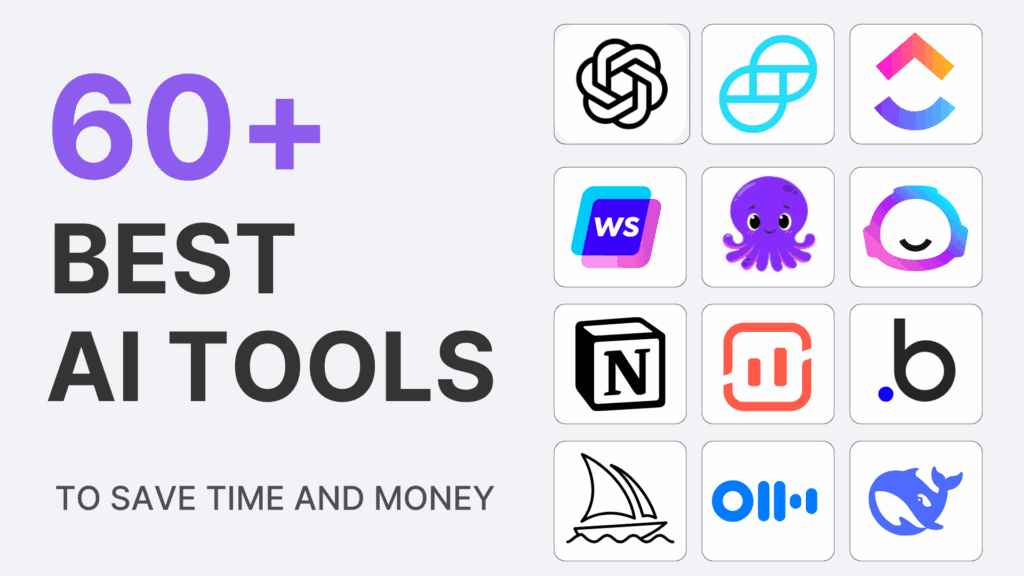Establishing a strong online presence, and effectively promoting your brand are on all marketing teams’ annual budget planning and agendas. Many eCommerce and retail businesses are diversifying their revenue and reach using the affiliate marketing model as a cost-effective lever to expand their reach, tap into new audiences, and generate more sales.
By leveraging the power of affiliate marketing, companies can tap into a vast network of influential individuals, creators, publishers, and websites that promote their products or services in exchange for a commission. A pay-per-play model that records a 15% CAGR and is projected to hit close to $ 30 billion market worth by 2030.
However, to truly maximize the benefits of any affiliate management activities, it is important to understand what Affiliate Marketing is and is not and how to partner with Public Relations (PR) professionals who can contribute to enhancing your brand’s visibility and reputation.
With that said, let’s review the exciting world of media partnership activities that include both the Affiliate and PR models and how to create a robust cost-effective strategy for your affiliate program utilizing performance PR tactics.
Let’s dive in!
Differences between Affiliate Marketing and PR
It is important to first explain what are the differences between the two models.
Affiliate Marketing and PR serve different purposes, yet their goals can align, making them powerful when managed in tandem.
There are several criteria to distinguish affiliate marketing from PR efforts such as follows:
- Purpose
- Primary Goal
- Partnerships
- Content Focus
- Measurement
- Timing
- Control
- Audience Reach
- KPIs
- Flexibility
- Data Utilization
Affiliate Marketing
Affiliate Marketing’s purpose is to drive sales and revenue through commissions (for the most part) and achieve measurable ROI.
The partnerships are made with affiliates, influencers, niche bloggers, and other creators with a sizeable audience and the content focus is usually on sales, promotions, and reviews.
The evaluation of an affiliate program is usually measured by sales, leads, revenue, ROAS, and conversion rates. The affiliate marketing model is quite flexible and can adapt quickly to changes in market trends and performance.
Public Relations (PR)
PR- on the other hand – manages reputation, builds brand awareness, and maintains positive media relationships.
The primary goal is to enhance the brand image and public perception. PR partnerships are focused on engaging with media outlets – think Meredith, Hearst, and other larger media powerhouses – journalists, and influencers.
All PR efforts are vehicle through press releases, articles, media pitches, and brand storytelling.
Measurement of success is based on a long-term focus on the evaluation of media coverage, media mentions, sentiment analysis, and of course brand visibility.
Affiliate Marketing and the rise of “Performance PR”
To align customer needs with brands’ overarching goals, affiliate and partnerships teams should utilize a full-funnel approach for their affiliate program based on segmented commission structures for affiliates that reward based on the value of the partnerships with publishers.
When it comes to investing in performance marketing efforts, the biggest black box of brands and merchants nowadays is keeping tracking and costs under control. With a full-funnel affiliate program strategy built with technologies enabling tracking and transparency, you get to half of the equation solved.
That’s when using ‘Performance PR’ tactics in your full-funnel affiliate marketing strategy you can solve the second half of the equation.
Performance PR – also known as results-driven public relations – is a strategic approach to PR that places a strong emphasis on measurable outcomes and tangible results, results that are usually available when running performance-based or affiliate campaigns with top media outlets.
Unlike traditional PR, which may focus more on activities like media outreach and press coverage, performance PR is all about connecting PR efforts to specific key performance indicators (KPIs) and business objectives. It seeks to demonstrate the value of PR by showing its direct impact on an organization’s goals and bottom line.
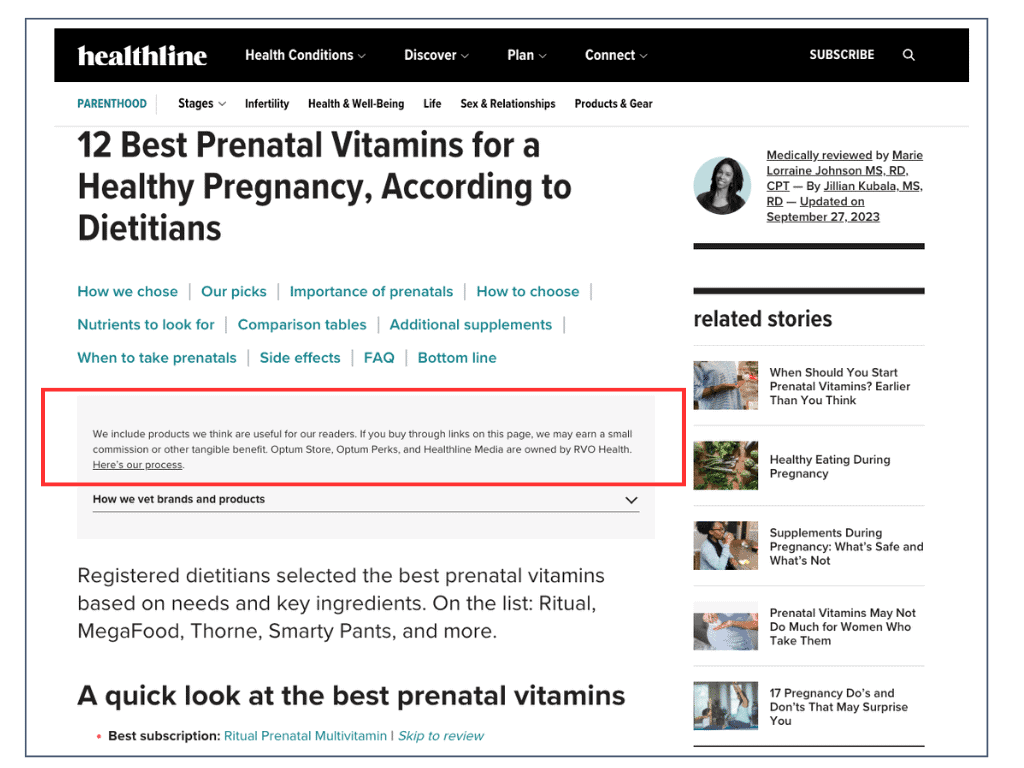
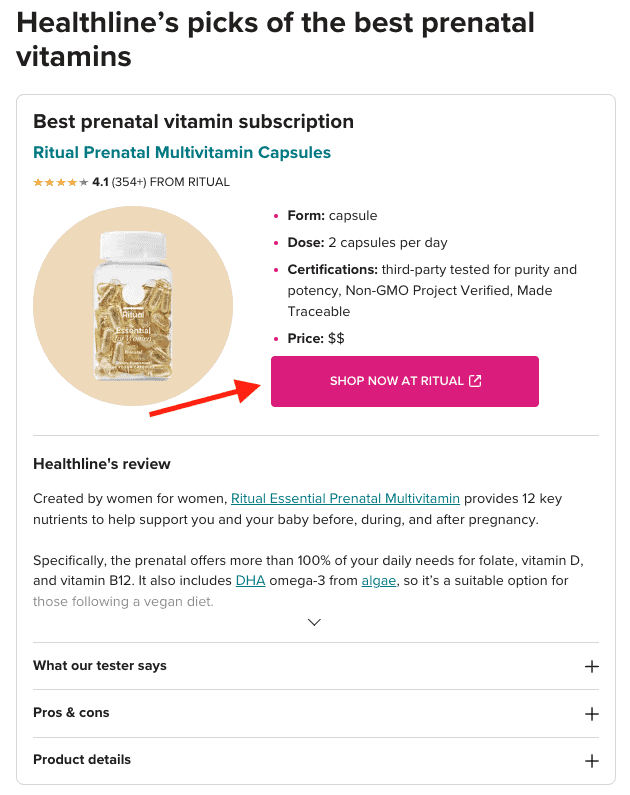
In the example, Ritual is getting featured in this Healthline article and for each order of their prenatal multivitamin, Ritual (the Advertiser), will pay Healthline (the Publisher) a 40% commission on sales, if the sales happen within 30 days.
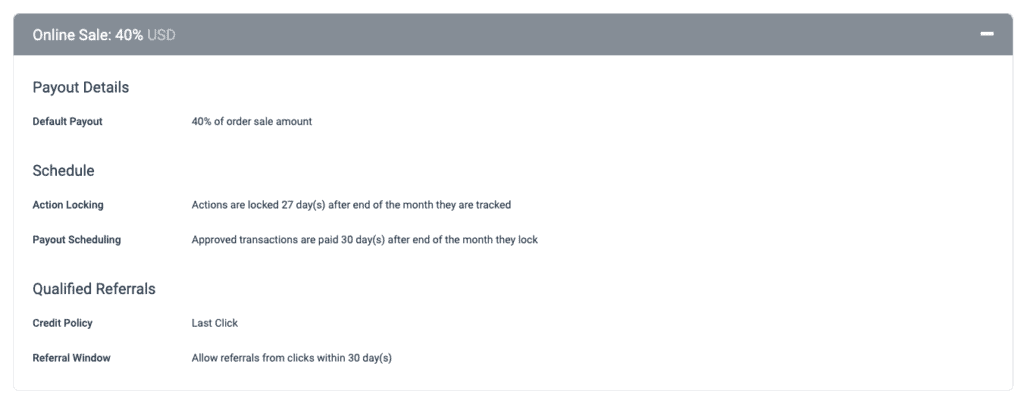
Note that the commissions are based on referred sales, not solely on the product listing driving the referred traffic.
That means that the higher Ritual’s AOV, the higher the commissions for Healthline.
While this is an excellent coverage opportunity for Ritual, it does not provide us with any other information about placement fees other than the 40% CPA.
For commerce content and review sites, it is common for publishers to require hybrid fees, that include a flat fee and a performance-based fee, for example, $3,000 + 40% CPA for featured placement and article reviews.
Performance PR efforts are managed by Affiliate program managers. With the rise of Commerce Content, enabled by brands and media to create unique shopping experiences for consumers, Affiliate Managers can now develop direct relationships with media and editorials to target audiences, and placements, and measure the impact of these efforts through measurable and trackable efforts.
Control of Cost and Performance
But what about cost control? That’s why partner diversification within a brand’s affiliate program is key. It allows brands to always keep control of costs and eliminate high dependency on some publisher groups while engaging with potential customers at various stages of their buying journey.
High-Funnel Performance PR recruitment
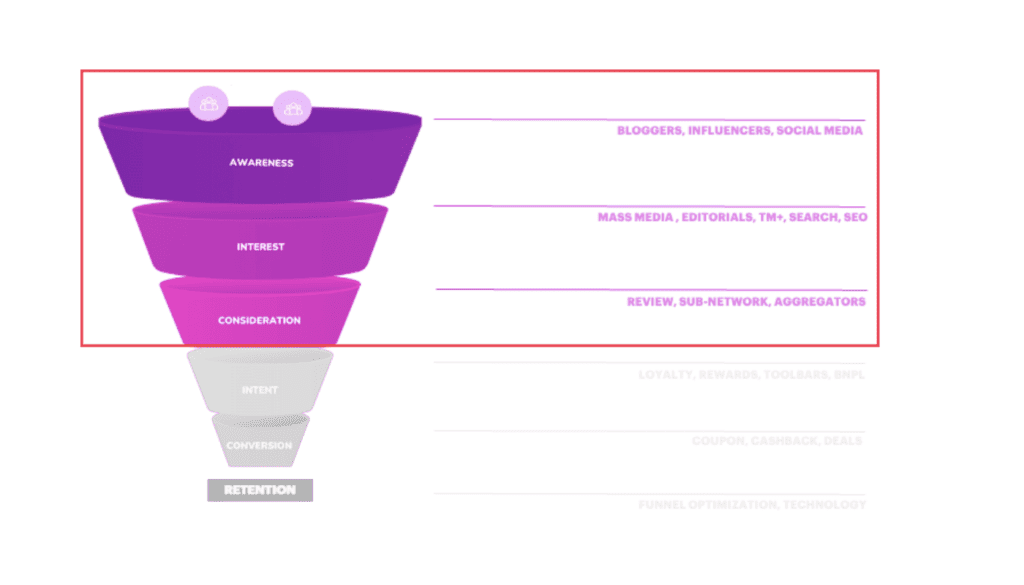
A robust full-funnel affiliate program strategy includes different levels of relationships set with different CPA and payout terms based on the value they will bring to the program:
High-funnel “Performance PR” recruitment, building relationships with top content, reviews, bloggers, or media publishers on a performance-based payout model or CPA. This will allow getting visibility on top publications while paying only for the conversion.
Content publishers are more and more willing to work on a CPA model than ever before. This will allow brands to track performance and attribution from impressions to conversions working with this group of affiliates. Tracking the performance of earned coverages in these publications was for a long time impossible.
But, with the rise of the performance-based model acceptance in the editorial and content publication spaces, it became easier to get access to build “PR” relationships between brands and top content partners without breaking the bank and having to pay high up-front placement fees.
‘Performance PR’ efforts provide a more effective ROAS on PR engagements and ensure guaranteed performance with these partner types. It does require negotiating higher CPA than for mid-to-lower funnel partners.
Performance PR efforts can 5X your affiliate program performance when coupling efforts with more traditional efforts with a PR team.
Mid-to-Lower Funnel recruitment of loyalty and deal partners
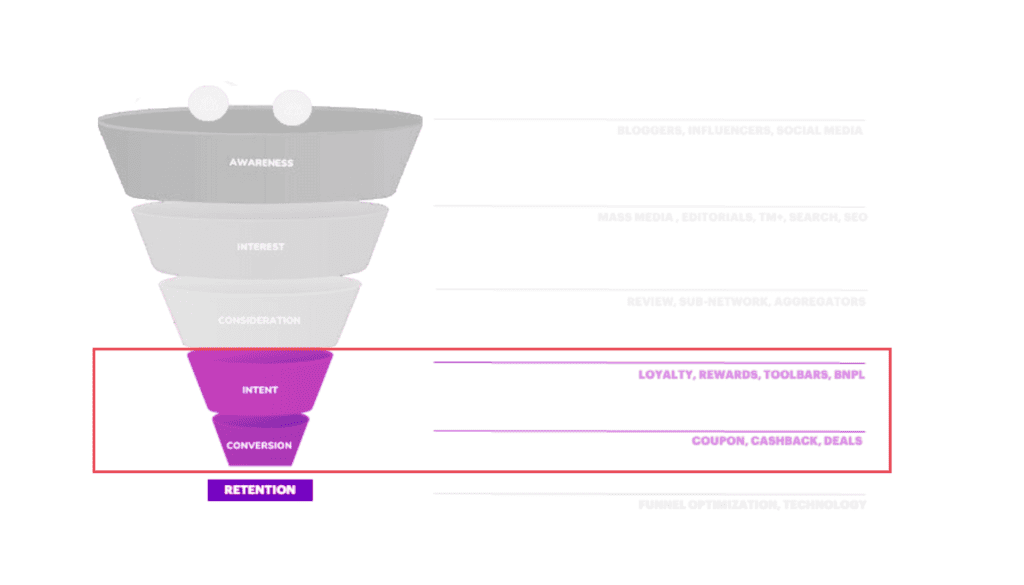
It is essential to recruit other partner types to your program such as loyalty partners. These sites usually incentivize their audience with deals and cashback on many brands and categories. Their audience is somewhat familiar with your brand or ready to purchase in the product category. Partnering with loyalty and coupon site partners not only facilitates conversions but also helps activate new-to-file customers and build higher LTV through loyalty and retargeting programs or through specific cashback or themed events.
At this level, and since these partners are high conversion facilitators, you should set up lower CPA and payout terms.
For more details, check out our article on how to grow a portfolio of affiliates by balancing diversification with performance contribution.
Ramping up your Affiliate program performance
Based on the initial full-funnel affiliate strategy, the market competition, KPIs trends, and specific promotional calendars, brands and merchants need to regularly revisit and adjust the commission payouts and contracts with their partners.
When to consider commission increases with Affiliates?
Commission increases are a good lever to build stronger relationships with key publishers; first, your team will need to review the publisher performance, identify what impact on the program a payout increase will translate into from a ROAS perspective, align on the terms with the publishers, and finally reach out to your partners to discuss the incentive and opportunities.
Commission increases are key to consider:
- to activate click-active publishers with high potential
- to incentivize top revenue-active partners during key seasonal events
- to negotiate with content partners willing to work on the CPA model and to prevent high flat fees
- to earn additional coverage and placements with key partners
- to fund higher loyalty and cashback sites ‘customers’ discounts and rewards
- Solidify Affiliate and PR efforts
Affiliate Marketing and PR Collaborations
We encourage brands to foster a transparent and open collaboration between their Affiliate and PR teams — whether these two teams are working in-house or managed by external agencies.
This collaboration will allow you to prevent duplicative efforts and credit conflicts between teams and clearly have them focus on targeting publication opportunities they’re best suited to achieve without overlapping efforts.
While Performance PR is a great way to establish relationships with top publications willing to work with a CPA payout model, a successful Affiliate program cannot be achieved without seeking earned coverages from a more traditional PR perspective where publishers will favor getting paid flat fees instead, regardless of the performance where the conversion happens or not. Brands literally pay for the placement and the opportunity to get in front of an audience.
Example of Affiliate and PR Teams workflow
A cost-effective Affiliate and PR team workflow to negotiate to earn coverage with top content partners usually consists of the following:
- The PR team shares and confirms promotions, product launches, and campaign initiatives through the promotional calendar, and emails pitches and assets to Accenture
- The Affiliate & PR teams discuss content targets and send out 1:1 outreach to editors and affiliate contacts. Secure earned coverage by offering content itself, product, commission
- The Affiliate team shares with the PR team information on interested content partners sourced through the Affiliate team and loops in the PR Team to content partner email to bring in a brand perspective
- If earned coverage interest is low or there is no interest, the Affiliate team incentivizes with an increased commission or sources paid opportunities for guaranteed coverage
- The Affiliate & PR teams thoroughly vet the opportunity (i.e., exposure, pricing, metrics) by inquiring about proposals and negotiating pricing
- The Affiliate & PR teams work together to customize and finalize a proposal.
- The Affiliate & PR teams track and report on performance and provide a strategy to stay on course or work with the PR team and content partner to pivot.
Data Sharing is key for the PR teams in this collaboration as Affiliate marketing efforts provide valuable consumer data that PR can leverage to craft more targeted pitches and campaigns.
Affiliate Marketing is a very cost-effective approach to earn media and partnerships with publishers, influencers, bloggers, and loyalty sites.
Wrapping-Up
In today’s fast-paced digital landscape, ecommerce brands are constantly seeking innovative ways to drive growth and boost their online presence.
We reviewed two essential strategies that often go hand in hand in achieving these goals; Affiliate Marketing and Public Relations (PR). While each approach has its distinct characteristics, they can work together seamlessly to maximize content creation, reputation building, data sharing, and control costs.
With the right full-funnel strategy in place powered by a smart partner recruitment strategy, a well-thought-tiered commission payout structure, and fueled by solid and transparent relationships with the PR partners, it will bring your ecommerce and retail businesses to the next level.
Your success starts with the Good Strategy!












